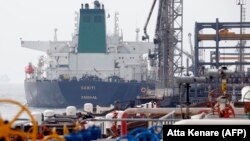Iran's unsold oil stockpile stored on land, floating in the Persian Gulf and on high seas at the end of January has remained unchanged since September 2019, as it has curtailed production.
Oil stockpiles stored on land stood at 61.6 and on the floating ships at 38 million barrels, respectively, the international energy information and tanker tracker company, Kpler, told Radio Farda. In September the total stockpiled oil was 104 million barrels.
Hemmed by restrictions, Iran's oil exports swiftly dropped after Washington reimposed its sanctions on the Islamic Republic, in 2018. Nevertheless, Tehran continued for months to produce more oil than it could sell, hoping to circumvent the sanctions.
The over-production reached a point that Iran's oil stockpile jumped from 47 million to almost 104 million barrels in autumn of 2019. Iran was basically running out of storage capacity.
Based on OPEC's data, Iran has decreased its oil production in recent months to below 2.1 million barrels per day (bpd). Therefore, with local consumption at 1.8 million, and exporting another 300,000 bpd, Iran has practically had no oil surplus. Hence, the volume of the country's stored oil with no buyers has not increased in the past months.
Kpler's report could mean that the days of over-production in Iranian oil fields are over, and the Islamic Republic has no more space to store its crude surplus.
Earlier, Kpler had informed Radio Farda that Iran had exported 277,000 bpd in January. Compared with the pre-sanctions era, the data shows a ten-fold drop in Iran's oil exports.
Under Washington's sanctions, Iran's oil production has also plunged from over 3.8 million to below 2.1 million bpd.
International Energy Agency (IEA) also verifies that Iran is currently exporting 300,000 bpd, mainly to China and Syria.
However, Iran does not receive any revenue from selling oil to Beijing. Reportedly, Tehran uses the income to pay its debt to China Petrochemical Corp (Sinopec) and China National Petroleum Corp (CNCP) for the development of Iran's super-giant Azadegan and Yadavaran oil fields.
The Chinese companies developed the fields after Japanese and European companies pulled out of the projects due to fears of sanctions over Iran's nuclear program. Both oil fields are in the oil-rich southwestern province of Khuzestan.
Washington and Beijing signed a trade agreement last month, and Chinese Customs' data shows that the volume of Iranian oil export to China in December dropped to below 100,000 bpd.
Since Washington withdrew from the Joint Comprehensive Plan of Action (JCPOA), or Tehran's nuclear deal with world powers, in 2018, the Islamic Republic has stopped publishing data on its oil production and exports.
Following the same secretive approach, Iranian Oil Minister Bijan Namdar Zanganeh told the state-run TV on February 4 that as he had always insisted, he would not give away any figures concerning the volume of crude oil exported.
"Although the (Iranian) people are our confidants, they are not the only ones hearing me; the enemies also do. In the middle of a war, one should not give away their position to the enemy, let alone to an enemy as ruthless as America," Namdar Zanganeh said, reiterating, "Therefore do not expect me to present any figure or information concerning Iran's crude oil exports."






